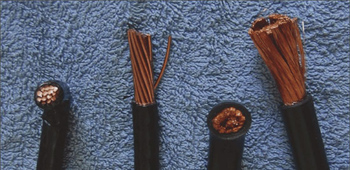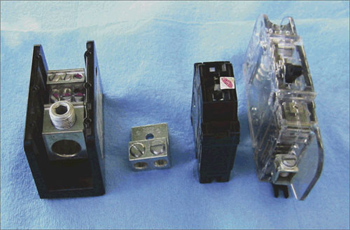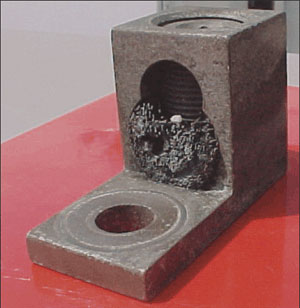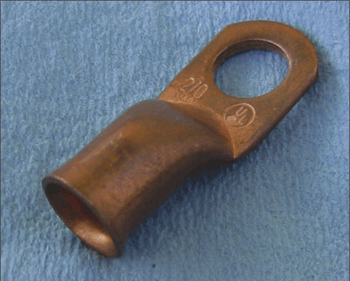The use of fine stranded, flexible cables appears to be increasing each year. This is particularly true with relatively “young” industries like the photovoltaic (PV) industry, the fuel cell industry, and the uninterruptible power supply (UPS) industries. In many cases, technicians and installers in these fields prefer to use fine-stranded flexible cables in the larger sizes (1/0 AWG and up) due to the perceived easier installation of these cables compared to the more rigid conventional cables.
Photo 1 shows the differences between a typical standard Class B cable and a typical fine stranded cable (sometimes incorrectly known as diesel locomotive cable or welding cable). Both cables are 2/0 AWG (67.4 mm2). The THHN Class B cable on the left has 19 separate conductors, each with a diameter of 0.084 in. (2.13 mm). The THW fine stranded cable on the right has 1330 separate conductors, each with a diameter of 0.01 inch (0.25 mm).

Photo 1. The differences between a typical standard Class B cable and a typical fine stranded cable
Note that both types of cables are listed in NEC Table 310.13 as suitable for code-compliant installations. Cables marked with only the DLO (Diesel Locomotive) marking are not suitable for code-compliant installations, and listed welding cables are only to be used when attached to the secondary of welding machines under the requirements of NEC Article 630.

Photo 2. Examples of setscrew types of terminals
Also of note, based on the values in NEC Table 5, chapter 9, is the overall diameter of the 2/0 THHN cable at 0.532 in. (13.51 mm) compared with an overall diameter of 0.610 in. (15.49 mm) for the THW. The greater diameter of the fine stranded THW cable is mainly due to the thicker insulting jacket required for THW cables. This generally indicates that fewer THW cables will fit in a given size of conduit.
Reports (unfortunately, mostly anecdotal) have been received over the last several years about field-made connections in PV and UPS systems that have failed when flexible, fine-stranded cables have been used with mechanical terminals or lugs that use a set screw to hold the wire in the terminal.

Photo 3. Failed terminal and cable
These terminals are found on nearly all circuit breakers (except those with stud-type terminals), fuse holders, disconnects, PV inverters, charge controllers, power distribution blocks, some PV modules, and many other types of electrical equipment. Photo 2 shows examples of a few of these set screw types of terminals.
Fine-stranded conductors and cables are considered as those cables having stranding more numerous than Class B or C stranding. Class B stranding (the most common) will normally have 7 strands of wire per conductor in sizes 18-2 AWG, 19 strands in sizes 1-4/0 AWG, and 37 strands in sizes 250-500 kcmil. Conductors having more strands than these are widely available and are in different classes such as K and M used for portable power cords and welding cables. Commonly used building-wire conductors such as USE, THW, RHW, THHN and the like are most commonly available with Class B stranding but are also readily available (in some locations) with higher quantities of stranding. Fine-stranded cables are frequently used by PV installers to ease installation and are used in PV systems for battery cables, power conductors to large utility-interactive inverters and elsewhere.

Photo 4. Failed terminal
Some PV modules are supplied with fine-stranded interconnecting cables (14 AWG–10 AWG) with attached irreversible compression connectors. While these crimped-on connectors listed with the module are suitable for use with the fine-stranded conductors, an end-of-string conductor with mating connector may also be supplied with the fine-stranded conductor, and the unterminated end of that conductor will not be compatible with mechanical terminals.
According to Underwriters Laboratories (UL) Standard 486 A-B, a terminal/lug/connector must be listed and marked for use with conductors stranded in other than Class B and C. With no marking or factory literature/instructions to the contrary, the terminal may only be used with conductors with the most common Class B and C stranded conductors. These terminals and lugs are not suitable and should not be used with fine-stranded cables. UL engineers have said that few (if any) of the normal screw-type mechanical terminals that the PV industry commonly uses have been listed for use with fine stranded wires. The terminal must be marked or labeled specifically for use with fine-stranded conductors [see NEC 110.3(A) and (B)].
UL suggests two problems, both of which have been experienced in PV systems. First, the tightening screw tends to break the fine wire strands, reducing the amount of copper available to meet the listed ampacity. Second, the initial torque setting does not hold and the fine strands continue to compress (creep) after the initial tightening. Even after subsequent retorquing, the connection may still loosen. The loosening connection creates a higher-than-normal resistance connection that heats, loosens even further, and may eventually fail. A recent example of a failed mechanical terminal from a large PV system is shown in photos 3 and 4. The terminal had been torqued properly less than three months before the failure.
Over-tighten or Retighten?

A quick review of NFPA Standard 70B-2002, Recommended Practice for Electrical Equipment Maintenance, does not find any suggestions that electrical equipment terminals be periodically retorqued. The terminals are to be inspected and examined for signs of looseness or overheating and that situation should be corrected where found. There is a retorquing recommendation for mechanical fasteners on box covers and the like.
Solutions
Electrical equipment listed to UL Standards has:
- Terminals rated for the required current and sized to accept the proper conductors
- Sufficient wire bending space to accommodate the Class B stranded conductors in a manner that meets the wire bending requirements of the NEC
- Provisions to accept the appropriate conduit size for these conductors where conduit is required.
It is therefore unnecessary to use the fine-stranded cables except possibly when dealing with conductors 4/0 AWG and larger. Experienced electricians and electrical contractors routinely install the normal, relatively stiff Class B conductors without difficulty and use parallel-connected smaller conductors where very large conductors are required.

Photo 6. Lug – suitable for fine-stranded cable
In those cases where a fine-stranded cable must be used, a few manufacturers make a limited number of crimp-on compression lugs in various sizes that are suitable for use with fine-stranded cables. These lugs are attached to a stud on the device using a washer and nut. Most of the commonly used overcurrent devices (both circuit breakers and fuse holders/terminals) come with screw-type terminals so there is no stud available. Most of these special crimp-on lugs are solid copper or tinned solid copper. Photo 5 shows a typical copper light-duty crimp-on lug that is not marked as being suitable for use with fine stranded cables.
Factory-supplied markings and literature indicate which lugs are suitable. An example is the ILSCO FE series of lugs in sizes 2/0 AWG and larger (see photo 6). Burndy makes the YA-FX series of lugs in sizes 8 AWG and larger that have been listed for use with fine stranded cables. In both cases the lugs are solid copper. It should be emphasized: Most crimp-on lugs are not listed for use with fine-stranded wire. Where the crimp-on compression lugs can be used, they must be installed using the tools recommended by the manufacturer and, of course, they must be attached to a stud with a nut and washer.
Other terminal manufacturers also make pin adapters (a.k.a. pigtail adapters) that can be crimped on fine-stranded cables. These pin adapters provide a protruding pin (solid or stranded) that can be inserted into a standard screw-type mechanical connector. Again, not all pin adapters/pigtail adapters are listed for use with fine-stranded conductors; some are intended for use with aluminum wire and others provide only a conversion to a smaller AWG size for a B Class conductor.
It is suggested that the use of fine-stranded conductors be avoided wherever possible. Where such cables must be used, they should only be terminated with the appropriate connectors/lugs. Previously installed systems should be revisited and the cables replaced where possible or terminated properly.
For Further Thought
Some of the requirements established by UL Standards are of the form: “Don’t do something unless it is specifically allowed by markings on the product or in the instructions.” An example is the use of fine-stranded cables discussed above. They are not to be used with a connector or terminal unless that connector or terminal is specifically marked allowing their use. Another example may be the Line and Load markings on circuit breakers where the absence of such markings indicate they are deemed suitable for backfeeding. Most of the dc circuit breakers used in the PV industry are marked with Line and Load, but are routinely used in a backfeed configuration on listed equipment.
Many of these “invisible” requirements were developed decades ago in the early days of the electrical power industry. Old-line firms like Square D, GE, T&B, Westinghouse, and the other manufacturers and users of electrical equipment have developed in-house procedures and standards to preserve the “old” corporate knowledge of these hidden requirements over the years as people come and go. It appears that “youngster” industries like PV, fuel cells, uninterruptible power systems and the like, may not have developed a means of first discovering and then preserving these “hidden” requirements. Additionally, the testing agencies may be overlooking some of these “’invisible” requirements in the testing and listing of equipment as their corporate memory retires.
The PV Industry (and possibly others) may have to implement a “”search and discover”” activity to ferret out these hidden requirements, develop methods to preserve the knowledge, and then ensure that they are met by our equipment and systems that must remain safe, reliable, and durable for 30+ years.
Installed or inspected any fine conductor cables recently?
For Additional Information
If this article has raised questions, do not hesitate to contact the author by phone or e-mail. E-mail: jwiles@nmsu.edu, Phone: 505-646-6105
A PV Systems Inspector/Installer Checklist will be sent via e-mail to those requesting it. A copy of the 100-page Photovoltaic Power Systems and the National Electrical Code: Suggested Practices, published by Sandia National Laboratories and written by the author, will be sent at no charge to those requesting a copy with their address by e-mail. The Southwest Technology Development web site (http://nmsu.edu/tdi) maintains all copies of the “”Code Corner Columns”” written by the author and published in Home Power Magazine over the last 10 years.
The author makes 6–8 hour presentations on “”PV Systems and the NEC”” to groups of 40 or more inspectors, electricians, electrical contractors, and PV professionals for a very nominal cost on an as-requested basis.














Find Us on Socials